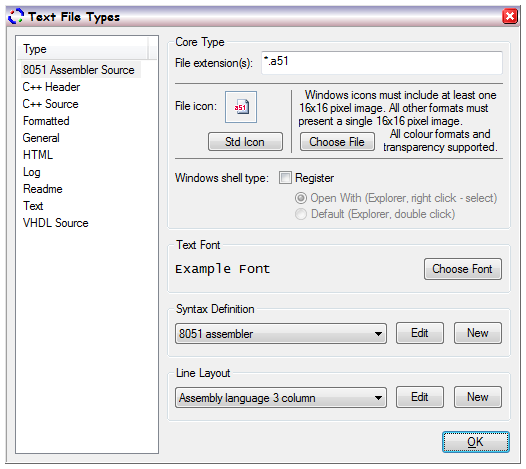 |
 |
 |
 |
 |
 |
 |
|
Managing File TypesOsmium provides a simple but effective method for managing the types of files it can work with. File type management works in conjunction with Syntax Management and Line Management which can be acessed through the dialog below, or directly through the application menu system.  File types - The status quoMost application software designed for the Microsoft Windows platform does not provide the capacity to dynamically manipulate file type information. This mainly occurs because applications will typically work with file types that they define. Such file type definitions are essentially private to the application. In other cases the actual file types are already clearly defined, because of some external specification or standard. An example might be the JPEG format. A JPEG is always an image, and it has either a .jpeg or a .jpg file extension. From the perspective of the operating system, and applications that work on it, these cases are easy to manage; Applications that use private file types may register those file types with an operating system when they are installed. Where a standard file type already exists, the operating system can create definitions for those types when it is installed, and subsequent application installations can hook into those definitions for their own purposes. Sometimes this hooking action can lead to confusion for the operating system, and users. Particular confusion can occur where two applications, quite validly, wish to register the same file type. Microsoft encorages application designers to register their file types in a standard way at installation. This leads to greater order in the list of applications and associated file types that the operating system maintains. File types - OsmiumUnfortunately for generic text editors, like Osmium, text file types are not particularly convenient to work by the status quo. Text files might typically have the file extension .txt, but .csv is also a form of text file, another example, .cpp. Each of these types of text file is handled differently depending on the extension, but they are all text files. When a user installs Osmium we don't know what sort of text files a user might wish to use. This gives us a peculiar challenge. The file type management dialog above helps to separate different file types out. Using the dialog it is possible to fit Osmium around your existing applications. Some types are registered to Osmium in the operating system. This works very much like the status quo except that the types must be manually registered after installation of Osmium by the user. Other file types may be completely local to the Osmium application. By default, Osmium registers no file types with the operating system when it is installed. It does have some of it's own predefined local file types. If you want the typical double click or right click Windows Explorer behaviour for particular Osmium text file types, then these can be individually registered in the dialog, to behave like the status quo, with just one click. Even if you don't register a file type with windows, Osmium can still work with a file of that type, it's just that files must then be opened through Osmium, rather than the Windows Explorer. |
Copyright © Solid Fluid 2007-2025 |
Last modified: SolFlu Wed, 07 Oct 2009 17:52:25 GMT |